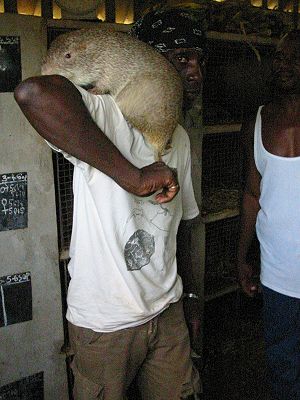Cane rats
| Cane rats | ||||||||||||
|---|---|---|---|---|---|---|---|---|---|---|---|---|

A male great reed rat ( Thryonomys swinderianus ) in a breeding station in Owendo, Gabon . |
||||||||||||
| Systematics | ||||||||||||
|
||||||||||||
| Scientific name of the family | ||||||||||||
| Thryonomyidae | ||||||||||||
| Pocock , 1922 | ||||||||||||
| Scientific name of the genus | ||||||||||||
| Thryonomys | ||||||||||||
| Fitzinger , 1867 |
The cane rats or grasscutters (Thryonomyidae) are a family of rodents . Despite their name, they are not closely related to rats , but belong to the group of porcupine relatives (Hystricomorpha). The family includes one genus, Thryonomys ( synonyms : Aulacodus, Triaulacodus or Choeromys ), with two species. These are: the great cane rat ( Thryonomys swinderianus ) and the little cane rat ( Thryonomys gregorianus ). They are called agouti in French-speaking Africa and grasscutter in English-speaking areas .
distribution
Reed rats are native to African forest and savanna areas (typically with precipitation of 750 to 1400 mm annually) south of the Sahara , their distribution area extends from Senegal and Sudan to Namibia and northern South Africa . They prefer zones with savannah grass and loose trees, but can also be found in floodplains and marshland.
description
Reed rats are large, rather clumsy rodents. Their coarse, bristly hair is colored yellow-brown or gray-brown, the underside is gray or whitish. They have a large, massive head with small eyes and small, round ears. Your sense of sight is poorly developed, but hearing and smell are all the better. The broad incisors of these animals are colored orange, the front is provided with three longitudinal furrows. The tooth formula is 1-0-1-3, a total of 20 teeth.
The limbs are short and strong, each foot ends in three big toes, the first and fifth toes are receded or missing entirely. Each toe has a claw suitable for digging. The sparsely hairy tail is significantly shorter than the body. Reed rats reach a head body length of 35 to 61 centimeters, a tail length of 7 to 26 centimeters and an average weight of 3 kg in females and 4.5 kg in males. Maximum weights are up to seven, in exceptional cases up to nine kilograms.
Way of life
As a habitat, cane rats prefer moist or even swampy habitats, with lots of grass, which serves as a privacy screen from predators (including wild cats and snakes) and as food. Sometimes you can also find them in ( grain ) fields and sugar cane plantations . In addition to the tall grass, they sometimes use crevices or abandoned burrows of other animals, such as aardvarks or porcupines, as shelter . If there is no shelter, they sometimes dig shallow burrows themselves. From their hiding place they create trails that allow them to get on quickly. Despite their clumsy exterior, they can run fast when needed, they are also excellent swimmers.
Reed rats are primarily nocturnal. They sometimes live together in small groups of one male and several females, during the dry season the male sometimes separates and lives solitary. One group lives in an area of around 3000 to 4000 square meters. Fights between males for supremacy in a group take place by trying to push each other away with their noses. If one releases the pressure, the other knocks it over and the fight is over.
food
The diet of the cane rats consists mainly of savanna grasses and reeds and is occasionally supplemented with tree roots, tubers, bark, fruits, grains and nuts. Sometimes they also invade plantations and consume sugar cane , corn , millet , cassava , sweet potatoes and other crops.
Reproduction
The mating time and frequency depends on the climate, in the wetter, warmer regions the female can give birth to offspring twice a year. The gestation period is between 140 and 170 days, the litter size between one and eight, an average of four. At birth, the female creates her own nest padded with grass and leaves. Newborn cane rats are hairy, have open eyes and flee the nest. Females have two or three pairs of side teats with which they suckle their offspring. Young animals reach sexual maturity between 4 and 12 months of age. The maximum age of an animal in human care was 4 years and 4 months.
Cane rats and humans
Reed rats can cause considerable damage in fields and plantations, which is why they are viewed and persecuted as a nuisance. On the other hand, their meat is an important food, they are hunted and there are attempts to breed the animals in Benin , Ghana and Nigeria , among others . In some African markets, more grasscutter meat is sold each year than cattle or pigs.
By penetrating plantations, their habitat has increased in recent decades. Despite all hunted, cane rats are common and are not endangered species.
Systematics
Fossil relatives of the reed rats have been known since the Oligocene and were also common in Europe and Asia during the Miocene . Today only two species exist, the great cane rat ( T. swinderianus ) and the little cane rat ( T. gregorianus ).
The closest relative of the pipe rats is the rock rat ( Petromus typicus ) living in southern Africa .
Web links
Individual evidence
- ↑ a b c d e f g h i j Dieter Nill, Elke Böhnert: Value chains for maintaining biological diversity for agriculture and food - potatoes from the Andes, Ethiopian coffee, argan oil from Morocco and grasscutters in West Africa, p. 57ff, German society for technical cooperation (GTZ), May 2006; accessed in February 2017
